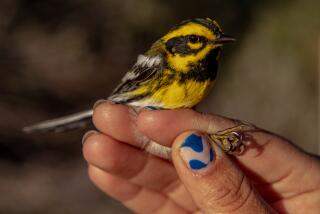A Mistake or Another Coup? Only Duck Knows for Sure
- Share via
In recalling recently that I had committed only my annual quota of two errors in 1991, I overlooked one.
It was in my column on the annual Jack and Denny Smith bird walk at Descanso Gardens. Among the many birds sighted that day, I included a ring-tailed duck; they were, in fact, rather abundant.
I am advised by Sylvia R. Gallagher of Huntington Beach (and several others) that there is no such bird. In fact, says Gallagher, the bird I saw was probably a ring- necked duck, there being many in residence at the Descanso pond.
(Another reader recalls that he wrote to point out that I had made three errors in one week, including two in one column. But he does not remember them and neither do I, so I am obliged to stick with my original accounting.)
I would like to plead that I had renamed the ring-necked duck because it, in fact, is ring-tailed. However, no such defense is available to me, as it is in the case of the scrub jay, which I think should be called a blue jay since it is 1) a jay and 2) blue.
In calling the ring-necked duck ring-tailed, I suspect I was just being forgetful, or careless. (It is possible, of course, that I saw a duck with a ringed tail.)
Southern California is so extravagant in its bird life that sharp-eyed birders are always sighting some species that has never been seen in this area, or some new species altogether. My ring-tailed duck may have been one of the latter.
Meanwhile, in an otherwise rather academic letter concerning his proposal for a modern testament for the Bible, Henry Childs, the honored ornithologist of Chaffey College, is kind enough to pay his respects to my celebrated sighting of the first (and only) common grackle in Southern California. (The bird is ordinarily seen only east of the Mississippi.)
“Let’s face it,” Childs writes. “You are the man who has done more for the grackle in California than Roger Tory Peterson, John James Audubon and Arnold Small put together.”
Actually, I haven’t really done anything for the grackle; I have just demonstrated that one must not put too much faith in fixed beliefs. That no grackle had ever been seen in Southern California did not mean I couldn’t see one in my back yard.
It is also interesting that no common grackle has been seen here since I saw mine. I have received several reports of sightings, but I doubt their authenticity.
Mickey Galef of Altadena wrote the other day that a friend named Elliot Zechlinsky, visiting from New York City, told her: “Yesterday I took a walk near the hotel (in Huntington Beach). I was very surprised to spot a grackle. You know, they are an East Coast bird, probably very rarely seen on the West Coast.”
I was surprised that Zechlinsky was so positive, but Galef points out that he is an avid bird-watcher and has led bird walks in Central Park for visiting birders.
If Zechlinsky’s sighting held up, I realized, he would share with me the honor of having sighted one of only two grackles ever seen in Southern California. Of course neither of us would have done anything special, except to be in the right place at the right time. But birding reputations have been made in less extraordinary circumstance.
I suspected, however, that what Zechlinsky saw was a boat-tailed grackle, a bird often mistaken for the common grackle. The boat-tailed grackle is becoming rather common in Southern California.
Galef had given me Zechlinsky’s number in New York. I called him. He wasn’t in, but I left my number and he called back.
I told him his friend had told me he said he’d seen a grackle. He said, “No, what I saw was a yellow-crown night heron. Very rare out there. “
I said, “Mickey Galef said you told her you saw a grackle.”
“I didn’t say I saw a grackle,” he said without much conviction. “Oh, well, maybe I did say I saw a grackle. You have a lot of black birds out there. But it’s highly unlikely.”
So Zechlinsky’s story breaks down into uncertainty, at best. I told him he might have seen a boat-tailed grackle, and he said that might have been it. “We have boat-tailed grackles in New York.”
By the way, Gallagher (who insists bird species should be capitalized) complained that bird names are often silly or inaccurate and that I might be forgiven for calling the ring-necked duck a ring-tailed duck. “That rusty ring on the neck is almost imperceptible against the bird’s blue-black plumage,” she said.
If, indeed, I did see a ring-tailed duck, it would be my second lifetime coup.






